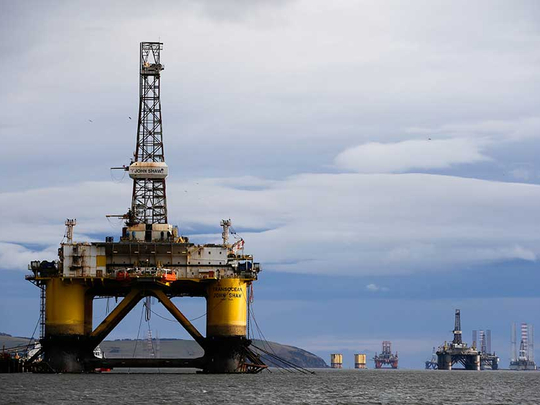
London: Listen to Saudi Arabia and hear the oil market is rebalancing. Look at the screen, and Brent is indeed holding above $50 a barrel. But dig deeper into the world of physical oil, and bearish signals abound, at least in the European market that helps dictate global prices.
The price difference between Brent crude for delivery in two months and three months — a yardstick telling traders how well supplied the market is — widened to minus 69 cents on Thursday, the biggest discount since February. Back then, the headline price for the grade was barely above $35 a barrel.
The weakness in the so-called time-spreads for Brent contrasts with a rally in headline prices above $50 a barrel as speculators bought in after Opec surprised traders by announcing the outline of a production cut in Algiers last month.
“Any deal is still far from being completed,” said Carsten Fritsch, commodity analyst at Commerzbank AG. “In the very short-term the market remains oversupplied not only by a small margin, but by a large one.”
Oil traders say the European and Mediterranean market is awash with crude as Nigeria and Libya ramp up production following sabotage, Russia increases output, and Kazakhstan’s massive Kashagan oilfield in the Caspian Sea starts pumping. North Sea production is also returning from summer maintenance. At the same time, refineries that process the oil are themselves undergoing seasonal work, eroding their demand.
More crude
“More light-sweet crude will be making its way into the Atlantic Basin and competing with Brent,” said Harry Tchilinguirian, head of commodity markets at BNP Paribas SA in London.
A further complication is that freight costs have risen from summer lows, hampering long-haul shipping and preventing traders from selling the European surplus into Asian markets or putting it into floating storage.
“The gloomy export outlook for Brent-related crudes to Asia is made all the more sombre by the growth in crude production in the already well-supplied Atlantic Basin,” said Stephen Brennock, at brokerage PVM Oil Associates Ltd in London.
The weakness in physical markets comes at time when money managers have been betting more than ever that oil prices will increase. Speculative net bullish, or long, positions in Brent and West Texas Intermediate combined rose to their highest level in data going back to 2011 last week.
The glut of crude in the physical market may spur some investors to shun those long positions before Brent futures for December expire at the end of the month. If traders want to maintain those positions, they will have to accept some losses to buy January contracts that are trading at a higher level, a condition called contango.
Speculators “now have to decide to either take profit” or “roll into a widening contango to maintain length into the next Opec meeting” on November 30, Olivier Jakob, head of consultant Petromatrix GmbH, said on Friday.
The biggest challenge for speculators is perhaps Nigeria, where production is returning after months of disruptions. The West African Opec country is expected to pump this month about 1.7-1.8 million barrels a day, up from a three-decade low of 1.39 million barrels a day in August.
Nigeria cut the price of every type of crude it sells on Tuesday in an effort to regain share of the global energy market at a time when its state-owned oil company said there’s a “huge” glut of cargoes. Libya, another Opec member, is also producing more. The country’s National Oil Corp. said last week it was pumping 560,000 barrels a day, which would be the highest level since November 2014, data compiled by Bloomberg show.
In Kazakhstan, the first barrels from the $50 billion Kashagan field have started to flow while Russian production is running so far this month at 11.2 million barrels a day, up about 100,000 barrels a day from last month and roughly 500,000 barrels a day higher than in August. The Russian increase in two months is equal to the output of Opec member Ecuador.
The flood of crude into Europe is at odds with comments from Khalid Al-Falih, Saudi Arabia’s Minister of Energy and Industry. The oil market is “clearly rebalancing,” bringing the industry to the end of a “considerable downturn,” he said at a conference in London on October 19.
Oil traders are unsure what will give. If time-spreads narrow that would support a rise in headline prices; should the contango keep widening, that could help bring down Brent. Opec, which meets November 30 in Vienna, will likely decide.












